 Sonny agreed to pose in the Santa Hat as did all the other horses and ponies and even our cat Murphy who can be see at the end of this blog'
Sonny agreed to pose in the Santa Hat as did all the other horses and ponies and even our cat Murphy who can be see at the end of this blog'
No matter when you start, it is important that you do not stop after starting. No matter when you end, it is more important that you do not regret after ended.
Sunday, October 31, 2010
Santa Hat
 Sonny agreed to pose in the Santa Hat as did all the other horses and ponies and even our cat Murphy who can be see at the end of this blog'
Sonny agreed to pose in the Santa Hat as did all the other horses and ponies and even our cat Murphy who can be see at the end of this blog'
Thursday, October 28, 2010
Gunks Routes: Gaston (5.8-)

(Photo: Past the pro-less start on Gaston (5.8-).)
Maryana and I were looking for something new to do on a beautiful Saturday in April, and it seemed like if we wanted something out of the ordinaryour timing couldn't be better, since we might not have any choice in the matter.We arrived at the West Trapps lot in the morning to find it was already nearly full, even though the temperature was still in the low 40's.As we walked down the carriage road it seemed like all theusual suspect climbswere occupied. It was the perfectoccasion for usto jump on something unpopular, something obscure.
When wepassed the connector trail I looked up at the cliff and saw theexpected sights. Climbers were on Arch (5.5). Climbers were on Strictly From Nowhere (5.7). But as usual no one was on the no-star climbs nearby: Calisthenic (5.7), Gorilla My Dreams (5.7), or Gaston (5.8-). And no one was on Splashtic (5.10a), a climb which gets a star from Dick Williams but which seems always unoccupied because the first pitch is 5.10 and the second is 5.9 R.
I was intrigued by Splashtic, because it seemed from the description that the crux is really one move, early in the first pitch. Looking it over on Saturday, I thought it looked doable and protectable. Maybe this was a good 5.10 candidate for me? I wasn't interested in the R-rated second pitch (although it sure looks exciting...) but I figured we coulddescend from the threaded anchor atop pitch one or continue with the upper pitches of another climb.
I was also interested in Gaston, because it has a reputation for being underappreciated and somewhat tricky for its 5.8- grade. I'd heard the upper pitches, which are just 5.5, were also good.
Maryana thought Gaston was a better choice for a warm-up than Splashtic so we were set.
Dick's guidebook describes the first pitch as going up a ramp and then moving right past a bulge. Then thin climbing left past two pins was supposed to be the crux.
For me the crux of pitch one was the lack of pro low on the pitch. There is nothing for at least fifteen feet or more. I went up the easy ramp and then expected to find something. But I didn't.
Then another move up and left onto a ledge. Still pretty easy climbing, but I was still lookingin vain forsome placements.
Finally I found gear, but it was to the left of the route. Theclimbingclearly went to the right through the bulge. I had two pieces but they were off-line.
After trying out a couple of different approaches I committed to the surprisingly thin holds and got through the bulge.
Then I think I got another piece, something micro, before moving up and left to an angle piton. (Dick mentions two pins but I guess one has since disappeared.) I don't remember these supposed crux face movesas tricky. There was nothing as thin as the move at the bolt on Wonderland (5.8-), for instance. All I really rememberwas wishingI had more confidence in the gear.But once I clipped the pin it seemed everything would be okay. The rest of the way I felt both the climbing and the gear were casual enough.
At the end ofthe pitchI felt like in retrospect there was JUST enough pro. And the climbing was nice; it was clean andinteresting. Maryana pointed out that I'd missed the key placement. There is a place right below the bulge where a runner could be threaded. You can see it in the above photo over to the right of where I have a sling connected to the blue rope. I had pro at the same height but off to the left. It would have been better-- I would have felt better-- if I'd found this placement.

(Photo: Maryana at the final overhangs on the 5.5 pitch two of Gaston.)
The next surprise on Gaston was that the threaded anchor atop pitch one was gone. I built a gear anchor and brought Maryana up. We had been thinking we'd rap after pitch one and go do something else, but nowwe wereforced to do at least one more pitch.
Maryana led pitch two and itturned out to bevery nice. We both enjoyed it. While pitch one features interesting face climbing, pitch two is moretypical Gunks terrain, with good features in a huge corner systemand plentiful horizontals, leading up and left to some final overhangs with jugs.
One we reached the GT Ledge we had an easy walk over to the bolted rappel route to our left. But I thought it was a waste not to finish the climb. We'd come this far. Would we ever bother to come to this spot again? Might as well do pitch three. It looked like a short romp up to a roof. Why not do it?

(Photo: Most of the way through the 5.5 pitch three of Gaston.)
I led the pitch in about five minutes. I'm glad we did it. It reminds me of the top pitch of Minty. It is a little harder and the move out to the roof is a bit more exposed. But it is very similar, featuring a nice corner and then another juggy overhang. Good fun.
I think Gaston is definitely underrated at no stars. It has a lot of quality climbing. Each pitch is worthwhile. The rock is good. It is clean. It should have at least a star. I think if the two 5.5 pitches were not guarded by the tricky pitch one this climb would beextremelypopular with new leaders.
As it is it should be more popular with moderate leadersof all levels of experience.
Monday, October 25, 2010
Hot, Hot, Hot
The temps are soaring in Washington, and gaining altitude on Mt Rainier is one way to avoid the heat. The last two weeks of July and the first two weeks of August historically mark the highest success rates and most reliable weather for the peak. If you're climbing, leave early, as the freezing level is hovering around 15,000 feet.
 Recent mountain achievements include Jason Edwards personal climbing benchmark. Jason successfully made his 300th summit climb of Mt. Rainier on July 12th. Jason joins an elit clan of guides (there are only 6) who have more than 300 summits. The current summit record is held by George Dunn, who has over 480 successful ascents.
Recent mountain achievements include Jason Edwards personal climbing benchmark. Jason successfully made his 300th summit climb of Mt. Rainier on July 12th. Jason joins an elit clan of guides (there are only 6) who have more than 300 summits. The current summit record is held by George Dunn, who has over 480 successful ascents.
In other news, we've updated the route condition reports for the Kautz, DC, and K Spire to name a few. Please keep the updates coming.
 Recent mountain achievements include Jason Edwards personal climbing benchmark. Jason successfully made his 300th summit climb of Mt. Rainier on July 12th. Jason joins an elit clan of guides (there are only 6) who have more than 300 summits. The current summit record is held by George Dunn, who has over 480 successful ascents.
Recent mountain achievements include Jason Edwards personal climbing benchmark. Jason successfully made his 300th summit climb of Mt. Rainier on July 12th. Jason joins an elit clan of guides (there are only 6) who have more than 300 summits. The current summit record is held by George Dunn, who has over 480 successful ascents. In other news, we've updated the route condition reports for the Kautz, DC, and K Spire to name a few. Please keep the updates coming.
Saturday, October 23, 2010
Rainy Day at Minnehaha Falls

Rainy Day at Minnehaha Falls, originally uploaded by ParsecTraveller.
I got this shot back in June when I was in Minnesota. This waterfall was gushing, more than I'd ever seen.
Anyone have some good waterfalls nearby?
Saturday, October 16, 2010
Wednesday, October 13, 2010
"Low Pressing" Systems
On another note, the solstice is coming up! There is lots of daylight
for climbers to complete their ascents. Lower freezing levels also make
later ascents more practical. New snow pasted on the mountain has made it quite the spectacular sight. Don't forget your cameras! See you up here soon.
Mountain Photography
When I was a kid Gaston Rebuffat's photos (and writing) inspired me and literally drove me to explore the mountains.




I've grown up but never loss the thrill ofseeingRebuffat'swork. Great mountain photography is like porn I suppose hard to define but you know it when you see it.
I am a huge fan of Chamonix based photographer and climber, Jonathan Griffith's work. How could a climber not be? Jon, shares his photos and trip reports on his various web sites. The content is good enough to get me back to Chamonix after being absent several decades.
http://www.alpineexposures.com/blogs/chamonix-conditions
And now he offering an amazing opportunity with aAlpine Photography Course.
http://www.alpineexposures.com/blogs/chamonix-conditions/6143764-chamonix-photography-course



Just a big thumbs up for the guys who make the effort to document and share our way of life.
Some great STOKE!




I've grown up but never loss the thrill ofseeingRebuffat'swork. Great mountain photography is like porn I suppose hard to define but you know it when you see it.
I am a huge fan of Chamonix based photographer and climber, Jonathan Griffith's work. How could a climber not be? Jon, shares his photos and trip reports on his various web sites. The content is good enough to get me back to Chamonix after being absent several decades.
http://www.alpineexposures.com/blogs/chamonix-conditions
And now he offering an amazing opportunity with aAlpine Photography Course.
http://www.alpineexposures.com/blogs/chamonix-conditions/6143764-chamonix-photography-course



Just a big thumbs up for the guys who make the effort to document and share our way of life.
Some great STOKE!
Tuesday, October 12, 2010
Weekend Summary
 |
| Something is up with this memory card, twisting up images |
 |
| From almost good to almost gone! |
 |
| Son of Beastwas looking good a few short days ago |
 |
| Laura seconding our warm up and only climb of the day |
Laura seconded the climb agreeing that the climb took on a little difficulty and upped the commitment level considerably. We enjoyed a cup of coffee at the top and made our way to the bottom. I decided to do a little dry tool bouldering across the blood wall. I started out with everything going well. Hooking, camming, steining I was like hercules making my way across, well not really, but I went to make a move left and my crampon got a little stuck. No big deal happens all the time. A little jostle and ping out it came. Thinking nothing of it I moved on making moves left. All of a sudden I realized I had no front point.
 |
| My dart became a DA. Time for some new ones. I might have to try the new Grivel G20. Watch for an upcoming review! |
We set off to climb ice, got shut out. Went to drytool, climbed a cool line again. Broke a crampon and called it a day... Par for the season. Maybe our luck will be better next time! Happy climbing to all
Thursday, October 7, 2010
Why Fixed Gear?
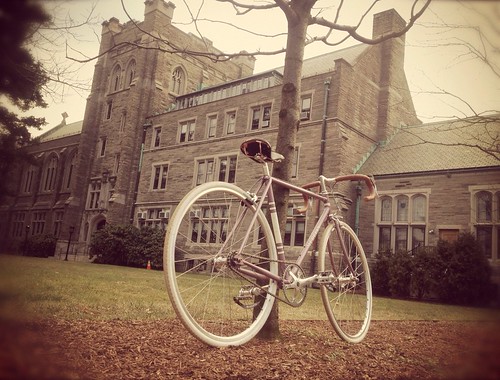 I have been riding fixed gear bicycles for about a year and a half now, and enjoy it so much that it is hard to talk about without getting embarrassed. Here in the Boston area, fixed gear is associated with a distinct cultural attitude and fashion sense, and I do not fit the mold. Seeing me on a bicycle with a fixed drivetrain often seems to surprise people, and I've been told on more than one occasion that I "don't seem like the type." While I suspect this is mostly used as a conversation starter by men, it still succeeds in making me self-conscious. What is it about fixed gear that I like so much and why do I "need" this type of bicycle?
I have been riding fixed gear bicycles for about a year and a half now, and enjoy it so much that it is hard to talk about without getting embarrassed. Here in the Boston area, fixed gear is associated with a distinct cultural attitude and fashion sense, and I do not fit the mold. Seeing me on a bicycle with a fixed drivetrain often seems to surprise people, and I've been told on more than one occasion that I "don't seem like the type." While I suspect this is mostly used as a conversation starter by men, it still succeeds in making me self-conscious. What is it about fixed gear that I like so much and why do I "need" this type of bicycle? I first tried a fixed gear bike in June . I was staying in Vienna and pining over the nearby velodrome's summer closure, and a friend offered to teach me to ride a track bike so that I could ride around the velodrome building (this seemed very funny at the time - around the velodrome, get it?). I was afraid to try it at first, but as soon as I got on the bike I didn't want to get off it. It felt so natural and intuitive. My friend ended up leaving the bicycle with me for the duration of my stay in Vienna and I rode it in the park after work every chance I got. Cycling slowly due to the lack of brakes, I must have looked like an idiot, but didn't care. I discovered that on fixed gear, my bicycle handling skills somehow improved. I could make tighter turns, cycle through narrow spaces, control my speed better, and just be more in control. It felt as if I suddenly gained a better understanding of how a bicycle worked. The custom Italian track bike made for a now-retired racer felt unexpectedly comfortable, save for the curvature of the handlebars. I could ride this thing for hours with a silly smile on my face. It became clear during those rides that I needed a fixed gear bike of my own once I returned to the US. A friend of a friend sold me a good road frame for fixed gear conversion, and I mailed it to myself in Boston before leaving Vienna.
I first tried a fixed gear bike in June . I was staying in Vienna and pining over the nearby velodrome's summer closure, and a friend offered to teach me to ride a track bike so that I could ride around the velodrome building (this seemed very funny at the time - around the velodrome, get it?). I was afraid to try it at first, but as soon as I got on the bike I didn't want to get off it. It felt so natural and intuitive. My friend ended up leaving the bicycle with me for the duration of my stay in Vienna and I rode it in the park after work every chance I got. Cycling slowly due to the lack of brakes, I must have looked like an idiot, but didn't care. I discovered that on fixed gear, my bicycle handling skills somehow improved. I could make tighter turns, cycle through narrow spaces, control my speed better, and just be more in control. It felt as if I suddenly gained a better understanding of how a bicycle worked. The custom Italian track bike made for a now-retired racer felt unexpectedly comfortable, save for the curvature of the handlebars. I could ride this thing for hours with a silly smile on my face. It became clear during those rides that I needed a fixed gear bike of my own once I returned to the US. A friend of a friend sold me a good road frame for fixed gear conversion, and I mailed it to myself in Boston before leaving Vienna. Waiting for the road frame to arrive (it took over 3 weeks!) I couldn't stop talking about my experience with fixed gear, and just for the heck of it one weekend the Co-Habitant and I converted the Motobecane mixte I then owned to a single speed with a fixed/free flip-flop hub. Doing this was easy and inexpensive. We picked up a budget wheelset, modified the existing crankset, shortened the chain and that was pretty much that. I rode this bicycle around the city and out to the countryside, and it was great fun. But I mostly thought of it as a novelty. On an upright bike, I preferred a freewheel. This bicycle was a great hit around the neighbourhood though, especially when I fitted it with some colourful dressguards. The woman who later bought it planned to use it as a freewheel single speed, but liked the idea of having the fixed option by flipping the wheel.
Waiting for the road frame to arrive (it took over 3 weeks!) I couldn't stop talking about my experience with fixed gear, and just for the heck of it one weekend the Co-Habitant and I converted the Motobecane mixte I then owned to a single speed with a fixed/free flip-flop hub. Doing this was easy and inexpensive. We picked up a budget wheelset, modified the existing crankset, shortened the chain and that was pretty much that. I rode this bicycle around the city and out to the countryside, and it was great fun. But I mostly thought of it as a novelty. On an upright bike, I preferred a freewheel. This bicycle was a great hit around the neighbourhood though, especially when I fitted it with some colourful dressguards. The woman who later bought it planned to use it as a freewheel single speed, but liked the idea of having the fixed option by flipping the wheel. Finally the vintage road frame I'd bought in Vienna arrived in the mail, and we quickly put it together. You might recognise this as the previous incarnation of theMoser I now ride as a geared roadbike. The tires here look huge, but they are 28mm Panaracer Paselas - the frame had just enough clearance for them if I did not use a rear brake. I rode this bike a lot, and particularly enjoyed it once it began to get cold. There was something about cold and dreary days on a fixed gear that was just magic.But while I loved riding the Moser, it became apparent over time that the frame was not really suitable for fixed gear conversion due to its very low bottom bracket. As my speed on the bike increased I started to get pedal strike when cornering on bumpy or uneven roads, and did not feel that this was safe. Last winter I began to look for another frame, which did not prove to be very easy given my criteria (lugged steel, horizontal dropouts, high bottom bracket, small size,and no toe overlap). I considered getting a frame from Royal H., but could not afford it. I considered the new SimpleOne from Rivendell, but learned that they would not be making one in my size. And that is how I came to be in possession of a Mercian.
Finally the vintage road frame I'd bought in Vienna arrived in the mail, and we quickly put it together. You might recognise this as the previous incarnation of theMoser I now ride as a geared roadbike. The tires here look huge, but they are 28mm Panaracer Paselas - the frame had just enough clearance for them if I did not use a rear brake. I rode this bike a lot, and particularly enjoyed it once it began to get cold. There was something about cold and dreary days on a fixed gear that was just magic.But while I loved riding the Moser, it became apparent over time that the frame was not really suitable for fixed gear conversion due to its very low bottom bracket. As my speed on the bike increased I started to get pedal strike when cornering on bumpy or uneven roads, and did not feel that this was safe. Last winter I began to look for another frame, which did not prove to be very easy given my criteria (lugged steel, horizontal dropouts, high bottom bracket, small size,and no toe overlap). I considered getting a frame from Royal H., but could not afford it. I considered the new SimpleOne from Rivendell, but learned that they would not be making one in my size. And that is how I came to be in possession of a Mercian. By the time I ordered this bicycle from Mercian, I had a good idea of what I wanted in a fixed gear. I did not want a track bike, but a comfortable and somewhat relaxed roadbike that just happened to have afixed gear drivetrain. I wanted to fit it with 28mm-32mm tires for road and occasional trails. I wanted it to have tame handling without feeling sluggish. All of this was done. When I began to ride this bicycle after we put it together, it was just the feeling I wanted. It is comfortable, intuitive, has no toe overlap or pedal strike, and I can ride it for quite a long time without getting tired.
By the time I ordered this bicycle from Mercian, I had a good idea of what I wanted in a fixed gear. I did not want a track bike, but a comfortable and somewhat relaxed roadbike that just happened to have afixed gear drivetrain. I wanted to fit it with 28mm-32mm tires for road and occasional trails. I wanted it to have tame handling without feeling sluggish. All of this was done. When I began to ride this bicycle after we put it together, it was just the feeling I wanted. It is comfortable, intuitive, has no toe overlap or pedal strike, and I can ride it for quite a long time without getting tired.So why fixed gear and what do I like about it so much? If I have to pin it down, there are two distinct elements of this type of bike that I enjoy. First, I simply find it soothing and pleasant. The motions my legs make on a fixed gear feel different - more circular and rhythmical.In that sense it is really not about speed at all, but about being able to ride with smooth and regular pedal strokes and enjoying the state of mind this puts me in. I find this to be very relaxing when I am stressed out. Even just riding in circles around the neighbourhood, the magical sensation of the drivetrain never fails to calm me down and clear my head.
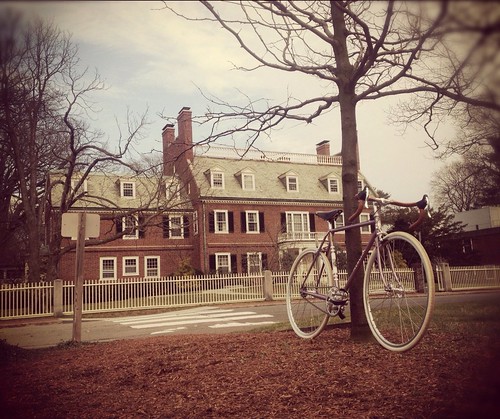 Second, I feel that riding a fixed gear roadbike helps me with technique. My movements feel more elegant and precise, and I can sense that I am developing a more intuitive sense of balance. I play games where I try to keep the bike going at all costs - slowing down to a crawl before a traffic light rather than stop as I wait for it to turn green. I also like to see how fast I can accelerate under different circumstances, and play "sprinting" games until I get out of breath. This is much more interesting to do on a fixed gear than on a freewheel bike, because once you get the drivetrain going it feels as if it "helps" you. All this may sound silly, but somehow I feel that things like this really help. Fixed gear bikes feel playful and very safe, which encourages me to try all this stuff that I would not normally try. Slowly but surely, I can tell that it improves my geared roadcycling skills - including the somewhat "duh" realisation that if I continuously pedal and feather the brakes instead of coasting, then I will feel more in control of my geared roadbike as well.
Second, I feel that riding a fixed gear roadbike helps me with technique. My movements feel more elegant and precise, and I can sense that I am developing a more intuitive sense of balance. I play games where I try to keep the bike going at all costs - slowing down to a crawl before a traffic light rather than stop as I wait for it to turn green. I also like to see how fast I can accelerate under different circumstances, and play "sprinting" games until I get out of breath. This is much more interesting to do on a fixed gear than on a freewheel bike, because once you get the drivetrain going it feels as if it "helps" you. All this may sound silly, but somehow I feel that things like this really help. Fixed gear bikes feel playful and very safe, which encourages me to try all this stuff that I would not normally try. Slowly but surely, I can tell that it improves my geared roadcycling skills - including the somewhat "duh" realisation that if I continuously pedal and feather the brakes instead of coasting, then I will feel more in control of my geared roadbike as well.But all this talk of technique is probably beside the point. When it comes down to it, we do things that we enjoy and fixed gear is for me simply one of those things. I can't imagine not owning a bike like this. I begin to get fixed gear cravings if I don't ride one for more than a week. Luckily, that should not be a problem.
Encased in Ice
What a difference a day makes!
Yesterday was a sunny, bright, beautiful day.
Today is dull and gray. And everything outside is encased in a layer of ice.
But if we have to have dull, gray, icy days, better today than yesterday! Because yesterday I had to take my mom to the doctor for a follow-up exam. That meant a 30 minute drive to Columbia City to pick her up then a 45 minute drive to Auburn. Fifteen minutes waiting to see the doctor, about ten minutes spent with him in the office, and then reverse the drive back home. I'm so glad yesterday was a nice day! And so very glad that I don't have to go out in this mess today!!
 The view from my front door. Doesn't look too bad? Well, there is about three inches of compacted slush, snow, ice and sleet in the drive. I haven't ventured out to the mail box yet. No traction. The pictures were all taken within 20 feet of the apartment and I used the flash to get some definition and contrast.
The view from my front door. Doesn't look too bad? Well, there is about three inches of compacted slush, snow, ice and sleet in the drive. I haven't ventured out to the mail box yet. No traction. The pictures were all taken within 20 feet of the apartment and I used the flash to get some definition and contrast.
Looking closely at the trees, shrubs and weeds you'll see there is about a ¼ to a ½ inch of ice covering everything. Not nearly as bad here as it is in Columbia City or South Whitley (where my niece lives and is currently without electricity) or further south. And not even close to what struck the northeast coast last week or the northwest this week. So we are very fortunate here. Most of the schools in the area closed for the day giving the kids an extra day for their winter break.




Yesterday was a sunny, bright, beautiful day.
Today is dull and gray. And everything outside is encased in a layer of ice.
But if we have to have dull, gray, icy days, better today than yesterday! Because yesterday I had to take my mom to the doctor for a follow-up exam. That meant a 30 minute drive to Columbia City to pick her up then a 45 minute drive to Auburn. Fifteen minutes waiting to see the doctor, about ten minutes spent with him in the office, and then reverse the drive back home. I'm so glad yesterday was a nice day! And so very glad that I don't have to go out in this mess today!!
 The view from my front door. Doesn't look too bad? Well, there is about three inches of compacted slush, snow, ice and sleet in the drive. I haven't ventured out to the mail box yet. No traction. The pictures were all taken within 20 feet of the apartment and I used the flash to get some definition and contrast.
The view from my front door. Doesn't look too bad? Well, there is about three inches of compacted slush, snow, ice and sleet in the drive. I haven't ventured out to the mail box yet. No traction. The pictures were all taken within 20 feet of the apartment and I used the flash to get some definition and contrast.Looking closely at the trees, shrubs and weeds you'll see there is about a ¼ to a ½ inch of ice covering everything. Not nearly as bad here as it is in Columbia City or South Whitley (where my niece lives and is currently without electricity) or further south. And not even close to what struck the northeast coast last week or the northwest this week. So we are very fortunate here. Most of the schools in the area closed for the day giving the kids an extra day for their winter break.




Tuesday, October 5, 2010
Rapha Women's Line, Take 2
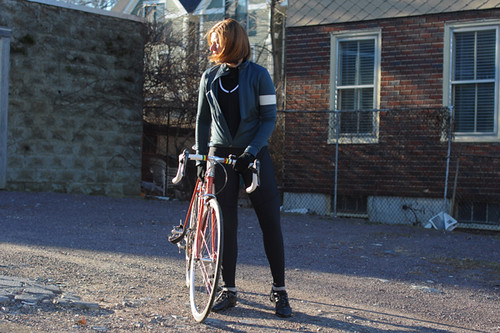
Over the summer I wrote about being underwhelmed with Rapha's women's line, but recentlycircumstances have encouraged me to give them another chance. And by circumstances I mean their 50% off winter sale, which coincided with the sudden demise of some of my current winter cycling clothes. Long story short, I now own several pieces of Rapha gear, two of which I will review here: the women's winter bib tights and long sleeve jersey. After mypreviousRaphapost, some felt that I intentionally used low quality pictures to exaggerate my criticism of the clothing. So this time I used a proper camera and did my best to show the clothing in a flattering light, freezing my butt of on a 20° day in the process. While I usually wait longer before reviewing a product, these are winter-specific and it is probably more useful to write about them now than once winter is over. Please keep in mind that the comments here are based on a very brief period of ownership.
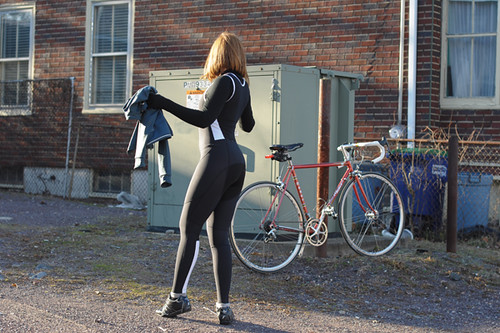
Rapha Women's Winter Tights
I decided to take a chance on theRaphawinter bib tights, because several women I know wear them and have good things to say about them. As you can see, these "tights" are pretty much a full-body jumpsuit. In my view that somewhat justifies the price of the garment, as the amount of warmth and coverage it provides is akin to what you would get from both tights and a vest. The fleece-lined tights are warm and windproof, designed for winter temperatures. At the time of this review, I have worn them on only one 30 mile ride so far in 25°F. My understanding (based on how others wear them) is that one dons these over a base layer and under a long sleeve jersey. For the purpose of demonstration I will show them here without a jersey on top.
I am a US size 4 and got the winter tights in Small. They are a very close fit, but also super-stretchy and don't constrict my movements at all, so I guess I am happy with the size. Multi-panel construction allows for a tailored look. The sizing seems designed for lean women with big thighs and a moderate bosom. If you are larger than a size B on top, consider going up a size or the torso might feel constricting. If you have very slim legs, consider going down a size or the tights might be loose. If you have a big bosom andslim legs... well, then you might be out of luck.

As far as quality, the tights seem to be well constructed, with no loose stitches or sloppiness. I won't really know until I wear them for at least a season though. The aesthetics are elegant, with the contrast piping and panels. Mesh panels in the shoulders and back aid temperature regulations and reduce tugging when in the drops.

The bottom is reinforced to prevent wear from contact with the saddle.There is a roomy pocket at waist-level in the rear that I could frankly do without (it adds some bulk under the top layer of fabric), but some might find useful. I could also do without the word "wheelsucker" embroidered on the right butt cheek. But I guess no one I ride with will ever see that, so I needn't worry.

A distinct feature of these tights is the large reflective strip on the back of the left calf (as another reviewer points out, the placement on the left is curious given that the manufacturer is English, but it works for American roads). I was riding with another woman who was wearing these, and the reflective strip made her very visible from a distance as she pedaled. The mesh stir-ups are another nice feature, as they keep the tights from riding up and exposing skin at the ankles while also being soft and stretchy enough to eliminate tugging.
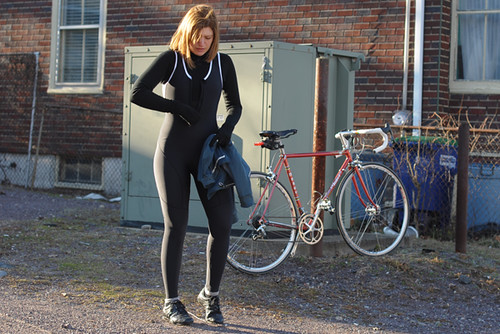
The front unzips to just above the belly-button. On a scale of 1 being easy to put on and take off and 10 being difficult, I would rate these as a 7. I would not want to be trying to pee in the woods in the dead of winter while wearing these bibs with several layers over them. The type of cycling I do is unlikely to call for that, but winter-peeing enthusiasts beware. What bothers me more, is that I find it quite difficult to smooth out my base layer inside the bibs - the zipper opening does not allow for enough reach. As a result, there is inevitably some unsightly bunching around my hips inside the bibs.
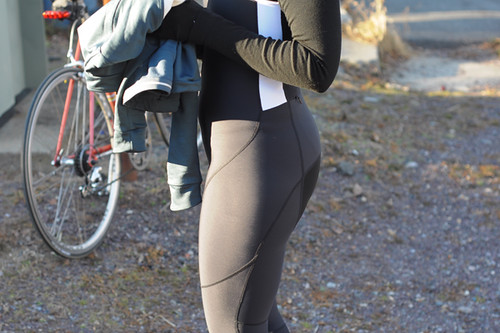
And finally there is the lack of a chamois. The tights are unpadded and meant to be worn over padded cycling shorts. The idea is that this way, you don't have to wash the entire massive jumpsuit every time you wear it and therefore it is a great feature. I can sort of see that, and I also appreciate that without the tell-tale pad these bibs can double as a cross-country skiing jumpsuit. But there is one thing that confuses me: Isn't the whole point of bibs to solve the problem of cycling shorts cutting into your abdomen? If so, it seems to me that the Rapha bibs rather fail at that aspect of things. Also, some might simply find it too bulky and constricting to wear fleece-lined compression tights over shorts. You may want to consider this aspect carefully before buying.
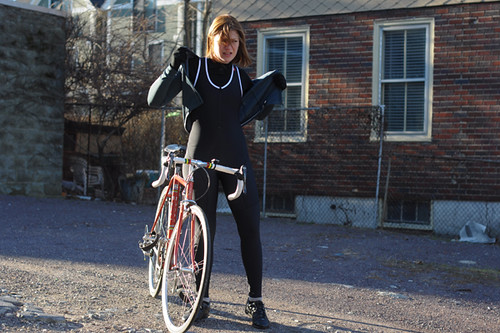
Summary: The Rapha women's winter tights are really more like a multi-sport full body jumpsuit. They are warm, easy to move in, attractive, and increase the cyclist's visibility on the road. On the downside, they are time consuming to put on and take off, while the lack of a chamois and the need to wear them over cycling shorts negates the waist-band eliminating benefits of bib tights and adds bulk. Given how warm these are, I am willing to deal with their limitations. But ultimately my opinion of their value will depend on quality. I really hope these last longer than a season! I would also suggest that Rapha consider offering a padded version for those who would prefer to carefully wash the chamoisto having to wear them over cycling shorts.
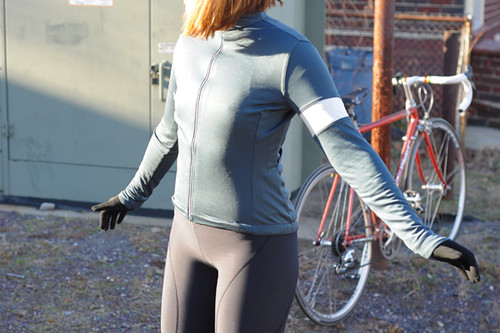
RaphaWomen's Long-Sleeve Jersey
I got thewomen's long sleeve jersey to wear as a midlayer underneath my winter cycling jacket. Again the purchase was motivated by positive feedback from a couple of other women who own this garment. There are several choices for colour schemes, and after agonising over the "fig" vs the "blue," I decided on the latter. It is a pleasant slate blue colour that transitions from gray to seafoamish depending on how the light hits it. I have worn this jersey on a handful of rides so far.
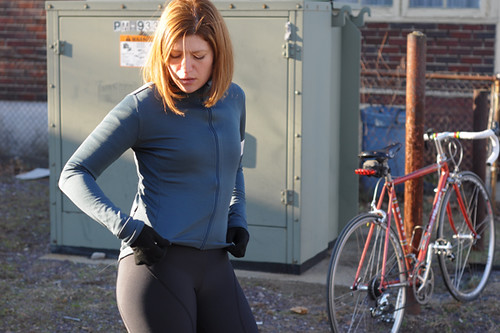
The size Small is spot-on for my US size 4 frame (worn over a sportsbra, long sleeve baselayer, and bib tights). As with other Raphawomen's items, if you have much in the way of bosom you may need to go up a size. The jersey has a full zip and drawcords to tighten and loosen the hem.
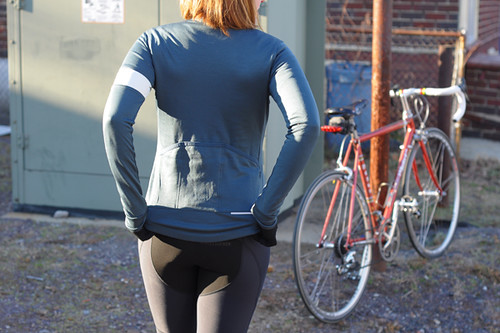
This is actually a nice feature, because on some of my current jerseys the hem is too loose and on others it rides up. It is hard to get that part right for women, because of the curvature of the hips - everyone's is different. There are three deep pockets in the rear, with an inner compartment for a small pump and a zippered compartment for credit card and cash.

As with other Raphajerseys, there is a high collar and a tab to prevent the zipper from digging into your neck. I like the colour-matched zipper and stitching; there is not too much going on in this jersey.
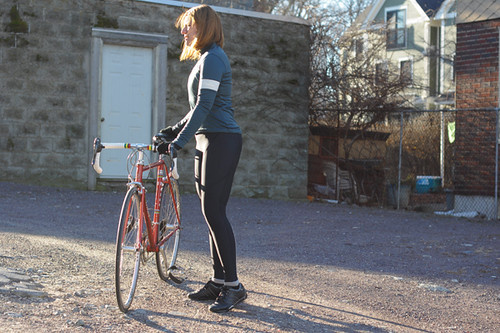
The white armband that screamsRaphais a feature I could do without very happily, though I understand that this is too much to ask. But I will say that, similarly to brands like Chrome, in a way Rapha has gotten itself into a corner with the strong visual branding. At this point there are people who would enjoy the functionality and quality of some of the garments, but are simply too embarrassed to wear Rapha because of what the branding has come to represent (roadie couture, backlit films of exquisite suffering, etc.). Maybe something to consider.

The fabric is "Sportwool" - 52% merino wool and 48% polyester. The surface of the fabric is smooth and shiny, almost shimmery in the sunlight. It does not look or feel particularly wool-like to me, so if you are seeking the tactile qualities of wool be aware. While I am not sure that I'd be able to wear this against bare skin (I am sensitive to polyester), over a merino baselayer it is fine. Most importantly, I find this jersey to be surprisingly warm, and the best insulating mid-layer I have tried so far. Prior to getting it, I was wearing a heavy Icebreaker turtleneck over my baselayer and it was neither as warm nor as breathable. A little disappointing, because I prefer 100% wool, but I have to admit that the Raphajersey does the job. Worn underneath a windproof shell, this setup has kept me comfortable on rides in temperatures in the 20s.

Summary: This is a wool-blend cold weather jersey with a number of useful features. While YMMV, it seems to work extremely well for me as a winter midlayer. The fit may be tricky for curvy bodies, and the tell-tale Raphaarmband is sure to cause some eye-rolling, but ultimately this is an effective garment that to me was worth the sale price.
Having examinedRapha's new additions to the women's line for - at a local retailer (the Ride Studio Cafe in Lexington, MA), they generally strike me as more flattering and more aesthetically pleasing than the items I commented upon in my previous post. I would love to see Rapha make a couple of jerseys in 100% merino, especially for the summer, a better fitting wind jacket in a more inspiring colour scheme for the warmer season, and arm warmers that are size-matched to their short sleeve jerseys. I would also love for Rapha to tone down some of the strong visual branding. I hope the Rapha women's line continues to expand. The more options for female cyclists, the better.
Sunday, October 3, 2010
Natural Bridges loop hike

Our second hike of the day brought us on a combination hiking/biking loop within Natural Bridges National Monument. The only road that goes through the park is a 9-mile one-way loop road, so this would end up being a perfect place to use our bikes in conjunction with a hike. The monument has 3 natural bridges along it's hiking trail and we were planning on doing 2 of the 3 bridges. The road through the park is up high on the mesa and the bridges are down low in the canyon. Hiking to each one means you have to hike down a very steep trail with about a 500 foot loss in elevation, then hike back up to return to the road. The bridges are also all connected by a trail that winds its way through the canyon. So, we left our bikes at the first trailhead, which is for Sipapu Bridge. We locked our bikes to the bike rack provided at the trailhead then drove to the trailhead for Kachina Bridge.

The hike down to Kachina Bridge was fascinating, as park service staff had used saws and drills to literally carve a trail out of the rock down into the depths of the canyon. Kudos to the NPS staff for building such a nice trail! About halfway down into the canyon Kachina Bridge came into view. We marveled at the view, then realized that these tiny dots we were seeing underneath the bridge were people. The bridge was positively HUGE! We continued hiking and reached the canyon bottom about 5 minutes later. The bridge was not visible right away when we reached the floor of the canyon but came into view after walking a short distance upstream. When it did come into view, we were awed by its massive size. The trail went underneath the bridge and I have to say, it was a little spooky walking under such a massive span of rock!

The next few miles of the trail were incredibly beautiful as we walked through the canyon towards Sipapu Bridge. We met a few people along the way, but this is not a highly visited park so it never felt crowded. As we walked the path we marveled at the black streaks lining the rock walls of the canyon. Every now and then we could hear birds calling in the distance. The temperature was perfect for hiking. We couldn't have asked for a better day! Eventually we rounded a bend in the canyon and Sipapu Bridge came into view. Sipapu is the 2nd largest natural bridge in the world. Only Rainbow Bridge on Lake Powell is bigger. The trail went part-way under this bridge before climbing up out of the canyon. It was a strenuous hike back up out of the canyon, due mostly to the fact that we were at about 8,000 feet in elevation and got winded easily. Once we were back at the trailhead we hopped on our bikes and really enjoyed the easy 2-mile bike ride back to the truck. According to the GPS unit, our loop was just over 8 miles, so we hiked about 6 miles and biked 2 miles. Back at the truck we made a couple of wraps for a late lunch then got back on the road. Our destination tonight was Capitol Reef National Park, the last stop on our southwest honeymoon.
Saturday, October 2, 2010
Weight Distribution Mysteries

One thing that continues to mystify me about frame design, is how different bicycles react to weight distribution. Over the years, I've really found this aspect of a bicycle's handling to be a wildcard. My Rivendell Sam Hillborne is built like a typical mid-trail touring bike, which, it is said, makes it optimal for carrying heavy loads in the rear but only moderate loads in the front. However, I prefer to ride this bike with an enormous handlebar bag, and it does very well with it. It also handles well with a saddlebag and panniers, but interestingly the handlebar bag - with the same amount of weight in it - does not appear to affect speed at all, whereas the saddlebag does a bit. If I am going on a fast ride, Iremove the saddlebag butdo not bother removing the handlebar bag. All of this is just fine with me, because I find it far more convenient to keep my stuff in the front for easy access. But it goes against my understanding of the way a bicycle like this is supposed to react to weight.

Then there is the Moser racing bike, which reacts badly to any weight I put on it at either end. The front gets twitchy with even a small bag attached. And with any saddlebag larger than a tiny wedge the bike feels distinctly rear-heavy. A few times I've affixed a mid-sized saddlebag so that I could carry my camera, and it felt like trudging through mud compared to the speed this bike is normally capable of. On the other hand, a full water bottle on the downtube (the bottle weighing about the same as my camera) has no effect, and neither does my own weight gain when I stuff my jersey pockets with all the things I would have otherwise kept in a bag.
Riding bikes like this has made me understand why some cyclists chose to ride with backpacks instead of baskets or panniers - some bicycles simply do not handle well with weight on either end, but do fine when the weight is part of the rider. This is one reason the argument "If you want to lighten your bike, lose some weight" does not make sense to me.You cannot simply take the combined weight of a bicycle, its accessories and its rider, and assume the handling and speed will be the same as long as the total remains the same.

My first city bicycle - a Pashley Princess - came with a huge front basket, but it did not handle well for me when I put things in the basket. Eventually I removed it and attached a set of rear folding panniers instead. With that configuration the bike handled much better, and faster. When I carried weight in the rear, I could detect no difference in speed, even with a full load of groceries.

On the other hand, the Bella Ciao city bike I now ride - while faster than the Pashley overall - is more sensitive to weight in the back. The handling doesn't change, but I can feel a difference in speed depending on how heavy the load I am carrying is.
With pretty much every bicycle I've ridden over an extended period of time so far, I've noticed some sort of relationship between weight distribution and handling, and it is not always a logical one - or at least not obviously so. I am sure there are lots of factors contributing to these effects, and these factors are just too nuanced to be obviously discernible. It's interesting to figure this stuff out in the process of getting to know a bike.
Subscribe to:
Posts (Atom)
